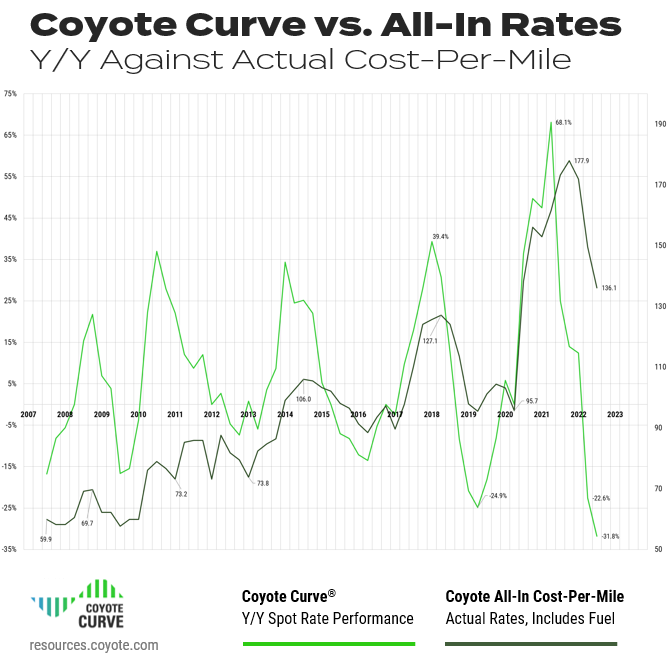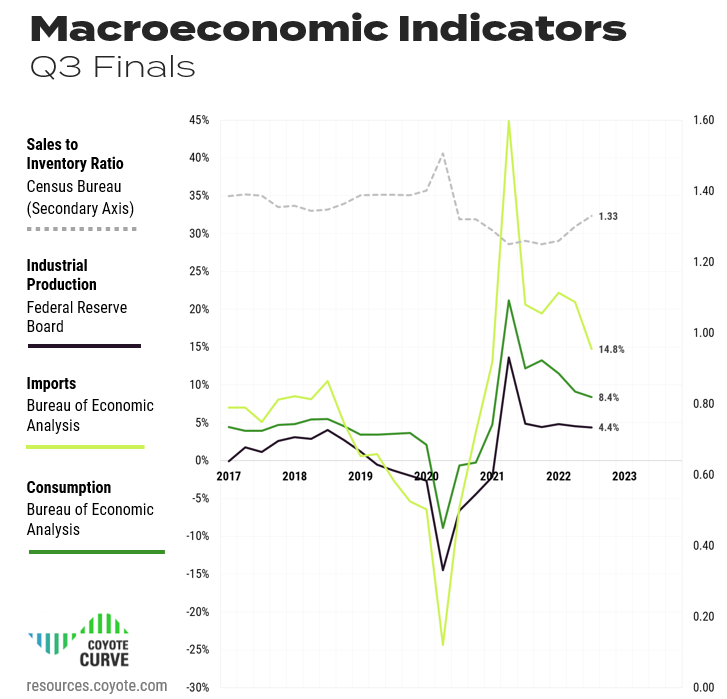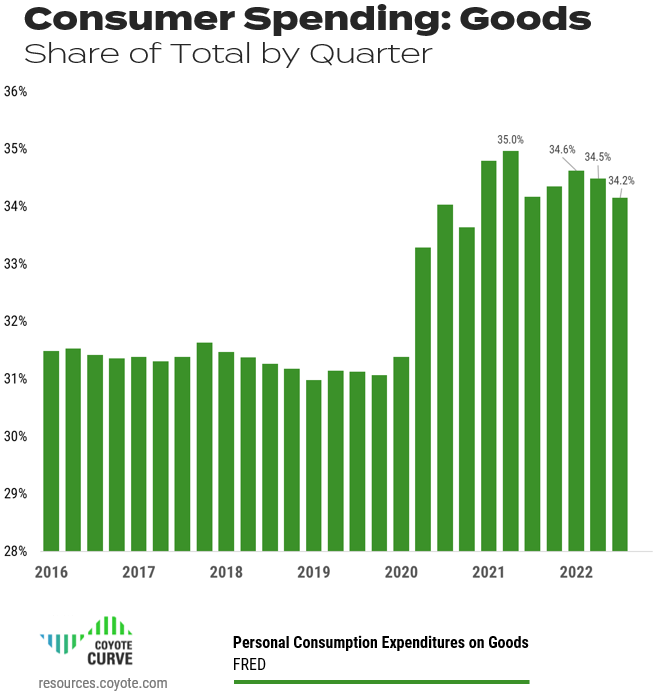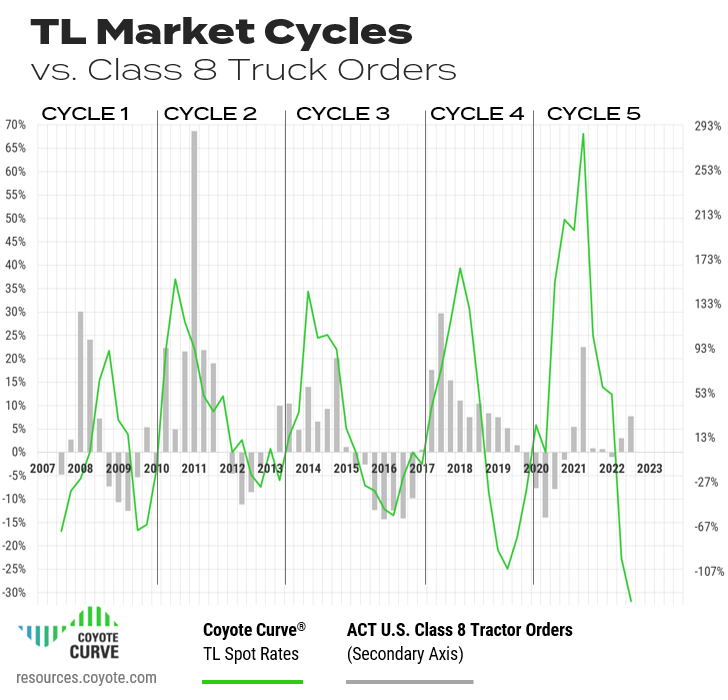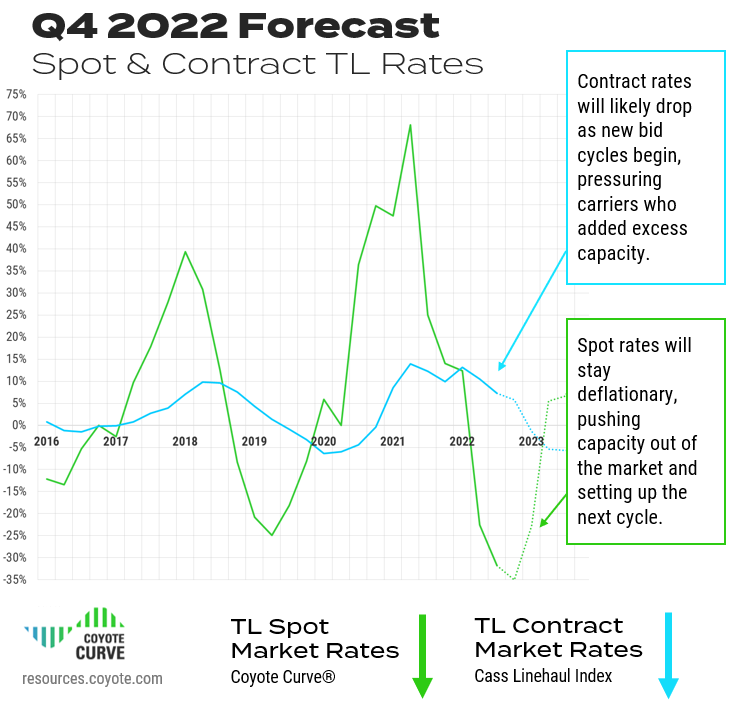Q4 2022 Truckload Market Forecast: Spot & Contract Freight Rate Trends
In our last update last quarter, despite rampant inflation and sky-high diesel, we finally saw our Coyote Curve® index cross the equilibrium line, diving deep into year-over-year deflation.
The Q3 numbers are in: did the U.S. truckload market continue it’s downward trajectory, or did continued inflation change the course of the market cycle?
How is peak retail season impacting trucking? Is it?
We’ll tell you everything you need to know in the Q4 Truckload Market Guide.
Q4 Truckload Market: The Complete Guide for Logistics Pros
- Q3 Truckload Spot & Contract Recap
- Current State of the Market
- How the Economy Is Driving Demand
- Trends Impacting the Market in Q4
- Q4 Truckload Market Forecast
- Download the Forecast Slides
New to the Coyote Curve?
These essential resources can help you build foundational knowledge on the truckload market and our proprietary spot rate index.
Q3 2022 Spot & Contract Trucking Rate Recap
Though inflation — both in the wider economy and fuel — persisted throughout Q3, we still saw an easier capacity and rate environment in the truckload market during the heart of the busy summer shipping season.
Spot rates continued to decline and carrier capacity was easier to come by, as is typical for this phase of the truckload market cycle.
However, after one of the fastest downward moves we’ve seen in Q2, the descent in Q3 started to level off, signaling we could be nearing a deflationary inflection point.
Let’s take a closer look.
Download these charts as high resolution slides for your next presentation.
Q3 Truckload Spot Rates Went Deflationary
- TL spot rates at the end of Q3: -31.8%
- Down from -22.5% Y/Y deflation in Q2
Q3 Truckload Contract Continued Downward Trend
(But Still Inflationary)
- TL contract rates*: 7.3%
- Down slightly from 10.5% in Q2
This is in line with past cycle behavior (typically lags spot rate index by one or two quarters)
Q3 Takeaway
Despite another quarter of high diesel prices and inflation in the wider economy, both spot rates and capacity continued to soften, driven by our place in the truckload market cycle (more on that below).
Current State: How Are Truckload Rates Still Going Down?
Through October, the Consumer Price Index (CPI) was up 7.7% compared to 2021.
In Q3, the average national price for a gallon of diesel was $5.51, a record high, and up 64% Y/Y.
How is it possible that truckload spot rates are still deflating? It’s a function of how supply and demand work in the truckload market.
What’s Driving Current Truckload Rate Deflation?
- Influx of Carrier Capacity
The market has been so tight for the last two years (and the spot market so lucrative) that carriers have added capacity into the market to meet demand, both adding trucks (when snarled supply chains allowed) and drivers (when tight labor markets allowed). - Wonky Year-Over-Year Comparisons
The Coyote Curve measures current spot truckload rates relative to last year. And Q3 2021 was near a record peak for our index, making the current drop look especially severe.
That said, actual rates are still declining (see below). - Shifting Consumer Spending Patterns
COVID-era spending was heavily weighted towards physical goods and less on the service economy (e.g., concerts, bars, restaurants).
We’re continuing to see more people spending their money on experiences and less on durable goods that require shipping.
Want Proof? Let’s Look at All-In Rates
Take a look at our Coyote Curve Y/Y spot rate index up against our proprietary all-in cost-per-mile index — this is comparing annual change versus the absolute rate.
(As a reminder, these numbers are informed by real transactional data from over 10,000 daily shipments spanning over 15 years.)
Though still well above pre-pandemic levels, the current all-in cost-per-mile is down over the past three quarters (and would be even more so if it weren’t for diesel rates).
Download these charts as high resolution slides for your next presentation.
Demand: Key Economic Indicators Driving the Truckload Market
Consumers are still experiencing inflation.
And though the truckload market and the economy are linked, they are not always coupled.
We’ve had several economic recessions with inflationary truckload markets — we could very well see an economic recession in 2023 and an inflationary truckload market.
Let’s examine the Q3 final numbers for industrial production, consumer spending, imports and inventories through the lens of how they are impacting truckload shipping.
Download these charts as high resolution slides for your next presentation.
Consumer Spending
After a several quarters of growth in 2021, consumption is showing signs of slowing, dipping down slightly from 9.2% at the end of Q2 to 8.4% at the end of Q3. This is likely driven by inflation.
We’re also seeing a rebalancing of consumer spending moving away from durable goods towards services, which impacts the amount of truckload shipping activity.
Overall goods spending is still elevated compared to pre-pandemic levels, but it’s declined sequentially in Q2 and Q3.
Industrial Production (IP)
Consumer spending, particularly on durable goods, drives production.
At the end of Q3, IP finished at 4.4%, remaining relatively flat over the last four consecutive quarters.
For the time being, this index is not pointing towards a recessionary environment, but if consumer spending takes a dive, expect IP to follow.
Imports
With chaos in international shipping markets over the past two years, this indicator has been particularly volatile.
After hitting a high of 44.9% last year, imports were down to 14.8% at the end of Q3.
With lower volumes, the port congestion that plagued Q1 and Q2 has essentially cleared up, even with peak season shipping.
Inventory-to-Sales
Over the past two years, to combat overall supply chain volatility and high demand, shippers built inventories.
They’ve stocked up on key items, carrying costs are starting to go up, driven by an increase in interest rates (the Fed’s response to inflation). Now, businesses are trying to shed any excess inventory.
This indicator is now coming to the forefront due to the pressure it will put on shippers’ bottom lines. At the end of Q3, the sales-to-inventory ratio increased for the third straight quarter to 1.33.
Economy Takeaway
Though inflation has started to impact consumer spending, it’s still holding strong through Q3.If this slows in Q4, so will production, imports and ultimately, freight volumes.
As shippers struggle with inventory carrying costs due to rising interest rates, it could further pull down freight demand.
Regardless of whether or not we dip into an economic recession, supply-side pressures will keep the truckload market cycle operating as usual (see below).
Truckload Market Trends to Watch in Q4
We are seeing several tell-tale signs of a stabilized capacity environment and are well into the deflationary leg of the truckload market cycle.
Before we dive into the updated Q4 forecast, let’s unpack a few of the key trends impacting the market this quarter.
1. Diesel Fuel
At the end of Q3, diesel was up ~64.1% Y/Y. Though slightly down (in year-over-year terms) from in Q2, it’s still well above pre-pandemic levels.
Download these charts as high resolution slides for your next presentation.
Diesel fuel, which represents around 30% of a carrier’s overall cost, can have a huge impact on a trucking company’s profitability if it rises or falls faster than freight rates.
In Q4, elevated fuel, combined with falling truckload rates, could drive out more carrier capacity from the market faster as their margins compress.
This would, in effect, elevate the floor that rates would fall to and shorten the amount of time we stay in a deflationary environment.
2. Class 8 Truck Orders
After historically long backlogs throughout 2021, supply chain shortages are easing and OEM’s are starting to fulfill truck orders.
Carriers who wanted to replace old equipment or add net new capacity are getting trucks in their lot (see Q1 and Q2 2021).
For some carriers, order fulfillment may not come as a welcome relief, but a financial burden — the market they bought those trucks in looks very different than the one they’re going to be when making those payments.
Orders were still inflationary in Q2 and spiked again in Q3, but many of these are likely to address replacement (which supply chain issues prevented) rather than net new at this point in the cycle.
This changing financial landscape could be an issue for many carriers as we head deeper into a deflationary market, which could pressure the supply side and potentially squeeze capacity out of the market, kicking off the next inflationary market.
Why Truckload Order Fulfillment Could Be a Burden:
- More trucks, less loads — they are adding more fleet capacity right when freight volumes are starting to fall.
- After several interest rate hikes from The Fed, equipment financing costs are much higher now compared to last year (when these purchase decisions were likely made).
- They are adding in large fixed costs to their budget, right when spot rates are dropping, with contract rates soon to follow.
3. Contract vs. Spot Rates
Though spot rates are already deflationary, contract rates remain inflationary…for now.
As we approach 2023 bid season, many shippers are looking forward to their next transportation RFP as an opportunity to bring their transportation spend back towards pre-pandemic levels.
Carriers currently running freight on primary rates are getting a significant premium to the spot market — through the mid-point of Q4, it’s near an all-time high.
When these primary rates reset in upcoming 2023 annual bids, they will start to feel the crunch, especially if they have new equipment on the books (i.e., fixed costs).
Again, this will contribute to the next inflationary leg of the cycle.
No Retail Peak Season?
Typically, we see a huge influx of shipping activity around the holidays, as imports hit the West Coast ports in September and October, and start to move to forward inventory locations for Black Friday shopping.
2021 was an epic Peak Season. This year is shaping up to be far more tame.
We’ve seen outbound California rates drop below the national average in November — the first time in seven months, and atypical for this time of year.
While we’ll still have some capacity tightening and spot rate hikes around the holidays, it’s going to much weaker relative to recent years.
Truckload Trends Takeaway
An influx of new trucks, high prices at the pump, declining spot rates, and soon-to-be dropping contract rates will all put pressure on the supply side.This will drive capacity out of the market, bringing about a deflationary inflection point and setting the cycle up for the inflationary climb.
Q4 2022 Truckload Market Forecast
We’ve covered the current state, the macroeconomic environment, and key trends — but where does it leave us going forward?
Let’s look at the forecast.
Download these charts as high resolution slides for your next presentation.
We expect spot rates to continue to deflate, even with Peak Season.
The spot trucking market still seems to be searching for a bottom. We think it’s likely we’ll find it in Q4, but it may push out into Q1 if fuel decreases, allowing carriers to absorb lower spot rates for a bit longer.
Regardless, we anticipate a loose capacity environment for the next one to two quarters, but expect that to turn in the back half of 2023.
What Can You Do?
There is no silver bullet or special trick — it comes down to fundamentals.
Use the (relative) lull in shipping environment to maximize planning and communication with your core freight providers.
As you head into a bid, be prudent about where you’re cutting rates and trimming capacity, keeping in mind we could be inflationary again before the end of 2023.
Are you sharing your data? Don’t try to hold onto any secret sauce — we’re all trying to solve for the same shipping problems, and the more collaboration the better.
If you want to learn more about how your peers are using supply chain data, you can get insights from over 1,500 shipping pros in our KPI benchmarking research study.
Forecast Takeaway
We’re well into a deflationary spot market and will likely stay there this quarter.Contract rates will follow, and capacity will start to exit the market, setting up the next inflationary rate environment, likely by second half of 2023 (regardless of whether or not we dip into an economic recession).
Continued Learning: Truckload Market 101
These three helpful resources will help you learn about truckload market fundamentals and how we build our proprietary index.
If you’re new to the Coyote Curve, take a few minutes to familiarize yourself with this foundational content:
Part I: Supply & Demand 101: Basics of Truckload Market Economics
Part II: Understanding the U.S. Truckload Market
Part III: Explaining the Coyote Curve
*We use the Cass Truckload Linehaul index as a proxy for contract rate performance.








